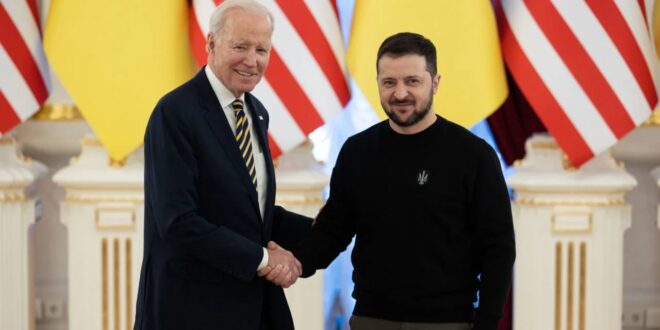It’s not too early to plan for Ukraine’s reconstruction as a strong, free-market democracy.
Today, the free world is united in supporting Ukraine in its struggle against Russian aggression and understands that the eventual winner must be the Ukrainian people, not Vladimir Putin. But while winning a war is important, winning the peace is just as critical.
When the current war in Ukraine ends, rebuilding the war-torn country will be crucial to the future of freedom and democracy.
Post-war Ukraine promises to be a vibrant civil society, perhaps even Europe’s next high-tech hub. However, its future will look bleak unless massive amounts of money are forthcoming to rebuild and restore its economy and infrastructure.
The World Bank Group, the European Commission, and the United Nations have released a new report estimating the cost of rebuilding the shattered country to be $486 billion, compared to $411 billion just a year ago. That includes replacing the estimated 10 percent of Ukrainian housing stock destroyed in the war, as well as repairing the damage to the transportation systems ($73 billion), commerce and industry ($68 billion), agriculture ($58 billion), and the energy sector ($49 billion).
The Biden administration’s recently announced plan to allocate $225 million to rebuilding Ukraine’s electricity grid is a proverbial drop in the fiscal bucket compared to the size of the problem.
Even with other governments and private entities pledging money to rebuild war-torn Ukraine, including channeling funds from frozen Russian assets, the amount needed is staggering—and a potential burden for taxpayers everywhere.
However, given the right legal framework and the proper infusion of venture capital funding, a free-market-oriented reconstruction policy could pay the way and even provide a return for investors.
In that spirit, we propose a modern version of the Marshall Plan for Ukraine, one that embraces the spirit of the original but rests on free market principles and incentives—ones that can engage today’s private and venture capital sectors as well as governments willing to help a new Ukraine rise from the ruins of the old.
The original Marshall Plan, which distributed more than $150 billion in today’s dollars to reconstruct war-torn Europe, succeeded beyond anyone’s imagination. One reason is that its authors understood that it was not up to the U.S. government to decide or dictate how reconstruction funds were to be used but rather the recipients. The plan’s architects were confident that those closest to the ground would find the quickest and most efficient way to rebuild their economies and societies.
As history shows, they were right.
The backbone of the original Marshall Plan was the Economic Cooperation Administration (ECA), which Congress created to distribute the plan’s infusions of aid. Seventy-six years later, Congress should look to create an equivalent ECA for Ukraine, one that would not provide loans to the Ukrainian government—agencies like the World Bank and European Bank for Reconstruction and Development are best suited for that task—but rather directly to the Ukrainian people to rebuild their businesses, neighborhoods, and lives.
Instead of saddling taxpayers with the bill, a modern ECA would find its initial seed capital through a consortium of countries contributing to a general fund for the reconstruction of Ukraine. This would include the United States and European Union (EU) members as well as non-Western economic powerhouses like Japan, India, South Korea, and Saudi Arabia. Hungary and Slovakia, who were reluctant to supply arms to Ukraine, may yet be willing to help rebuild their war-ravaged neighbor. Countries like China or Iran that provided Vladimir Putin with arms or other material support should be specifically excluded from the ECA consortium.
As a first step, the ECA would then turn the consortium’s seed capital into direct loans to the Ukrainian private sector, including businesses, families, and individuals. These loans would then be securitized, with the ECA selling tax-exempt securities across all participating nations— securities backed by the donor country’s loan guarantees. This would instantly make them highly attractive investment-grade bonds while simultaneously boosting available capital for Ukraine’s reconstruction.
The sale of these securities to investors would also continually replenish the ECA’s lending pool, even as the original capital would be continually paid out in the form of loans.
The overall impact of ECA funding on Ukraine’s reconstruction could be enormous. Applying the standard velocity of money formula, an initial infusion of $150 billion in seed capital could mobilize as much as half a trillion dollars for Ukrainian reconstruction—especially if the seed capital included frozen assets confiscated from Russian bank accounts, which the EU has already agreed to do.
Indeed, the ECA could be the go-to authority to distribute those confiscated funds in the form of specific grants to rebuild schools and local infrastructure—projects that are crucial to Ukraine’s future yet cannot be expected to generate the profits needed to repay the original ECA loans.
Finally, when the ECA is ready to close its doors and shut down its operations, it should be ready to send back a substantial return to its seed capital investors—a prospect current reconstruction plans cannot guarantee, let alone offer.
How soon could the administration and Congress act on authorizing an ECA for Ukraine? As we have learned, it is never too early to start winning the peace. There is no reason to wait until the war in Ukraine is over to begin the work of reconstruction. Portions of western Ukraine that are less scarred by war can act as the sites of pilot programs.
Although this plan relies on venture capital and the private sector, it will pay strategic and financial dividends. Just as the original Marshall Plan served to halt the spread of Soviet influence over postwar Western Europe, the rapid reconstruction of Ukraine as a vibrant, free market economy will be a bulwark against Russian imperial designs in Eastern Europe. It can also open a new chapter for Europe as a whole and demonstrate how democracy and freedom can be rekindled from the ashes of war.
 Eurasia Press & News
Eurasia Press & News



